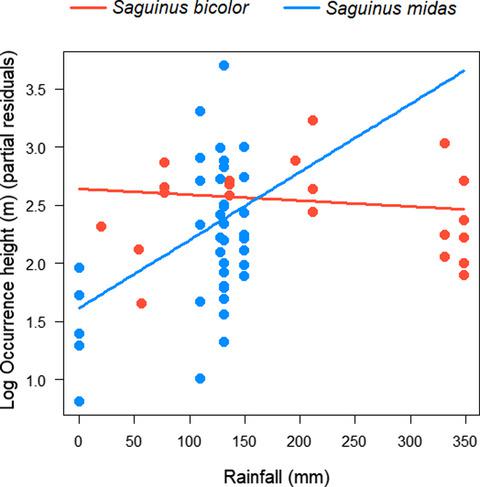当前位置:
X-MOL 学术
›
Austral Ecol.
›
论文详情
Our official English website, www.x-mol.net, welcomes your
feedback! (Note: you will need to create a separate account there.)
Does co-occurrence drive vertical niche partitioning in parapatric tamarins (Saguinus spp.)?
Austral Ecology ( IF 1.6 ) Pub Date : 2021-07-19 , DOI: 10.1111/aec.13085 Tainara Venturini Sobroza 1, 2 , Pedro Aurélio Costa Lima Pequeno 3 , Marcelo Gordo 2, 4 , Natalia Margarido Kinap 1 , Adrian Paul Ashton Barnett 1, 4 , Wilson Roberto Spironello 1
Austral Ecology ( IF 1.6 ) Pub Date : 2021-07-19 , DOI: 10.1111/aec.13085 Tainara Venturini Sobroza 1, 2 , Pedro Aurélio Costa Lima Pequeno 3 , Marcelo Gordo 2, 4 , Natalia Margarido Kinap 1 , Adrian Paul Ashton Barnett 1, 4 , Wilson Roberto Spironello 1
Affiliation

|
Stable species coexistence is a result of a balance between niche and fitness differences. One of the most common competitive patterns that arise from interactions between closely related species is character displacement, which may lead to divergence of certain traits and niche partitioning in areas where species co-occur. In this study, we used data on 35 groups of two parapatric tamarins (Saguinus midas and S. bicolor) to test for asymmetries in group size and competitively driven divergence in forest strata use, under the influence of resource availability fluctuation across the year. We hypothesised that S. midas is competitively superior to S. bicolor, and this would result from differences in fitness-related traits (group size). If so, species patterns of vertical habitat across the year should shift in sympatry relative to allopatry. We found that species had similar group sizes, suggesting they have similar competitive abilities. Further, both pied and red-handed tamarins used lower heights whenever in larger groups, which may be related to a diet shift in response to increases in intragroup competition. In addition, we refuted our prediction of vertical niche partitioning in sympatry. Instead, S. midas moved upwards into the canopy with increasing rainfall over the year (a proxy for resource availability) both in sympatry and allopatry, whereas S. bicolor was unresponsive to both rainfall and geographic contact with S. midas groups. Therefore, the difference in vertical habitat use between these species over part of the year is probably more related to the degree of resource seasonality experienced by each species within their ranges, than to competition.
中文翻译:

共生是否会驱动旁系狨猴(Saguinus spp.)的垂直生态位分区?
稳定的物种共存是生态位和适应度差异之间平衡的结果。由密切相关物种之间的相互作用引起的最常见的竞争模式之一是特征置换,这可能导致某些特征的分歧和物种共同出现的区域的生态位划分。在这项研究中,我们使用了 35 组两种旁缘狨(Saguinus midas和S. bicolor)的数据来测试在全年资源可用性波动的影响下,群体规模的不对称性和森林地层利用的竞争驱动差异。我们假设S . Midas在竞争上优于S. bicolor,这可能是由于与健康相关的特征(群体规模)的差异造成的。如果是这样,一年中垂直栖息地的物种模式应该相对于异域分布发生同向变化。我们发现物种具有相似的群体规模,表明它们具有相似的竞争能力。此外,无论何时在较大的群体中,花斑和红手狨都使用较低的身高,这可能与为应对群体内竞争的增加而改变饮食有关。此外,我们驳斥了我们对 sympatry 中垂直生态位划分的预测。相反,S. midas向上移动到树冠中,随着一年中降雨量的增加(资源可用性的代表)在同向和异向中,而双色 S. bicolor对降雨和地理接触都没有反应S. 迈达斯集团。因此,这些物种在一年中部分时间的垂直栖息地利用差异可能更多地与每个物种在其范围内经历的季节性资源程度有关,而不是与竞争有关。
更新日期:2021-07-19
中文翻译:

共生是否会驱动旁系狨猴(Saguinus spp.)的垂直生态位分区?
稳定的物种共存是生态位和适应度差异之间平衡的结果。由密切相关物种之间的相互作用引起的最常见的竞争模式之一是特征置换,这可能导致某些特征的分歧和物种共同出现的区域的生态位划分。在这项研究中,我们使用了 35 组两种旁缘狨(Saguinus midas和S. bicolor)的数据来测试在全年资源可用性波动的影响下,群体规模的不对称性和森林地层利用的竞争驱动差异。我们假设S . Midas在竞争上优于S. bicolor,这可能是由于与健康相关的特征(群体规模)的差异造成的。如果是这样,一年中垂直栖息地的物种模式应该相对于异域分布发生同向变化。我们发现物种具有相似的群体规模,表明它们具有相似的竞争能力。此外,无论何时在较大的群体中,花斑和红手狨都使用较低的身高,这可能与为应对群体内竞争的增加而改变饮食有关。此外,我们驳斥了我们对 sympatry 中垂直生态位划分的预测。相反,S. midas向上移动到树冠中,随着一年中降雨量的增加(资源可用性的代表)在同向和异向中,而双色 S. bicolor对降雨和地理接触都没有反应S. 迈达斯集团。因此,这些物种在一年中部分时间的垂直栖息地利用差异可能更多地与每个物种在其范围内经历的季节性资源程度有关,而不是与竞争有关。











































 京公网安备 11010802027423号
京公网安备 11010802027423号